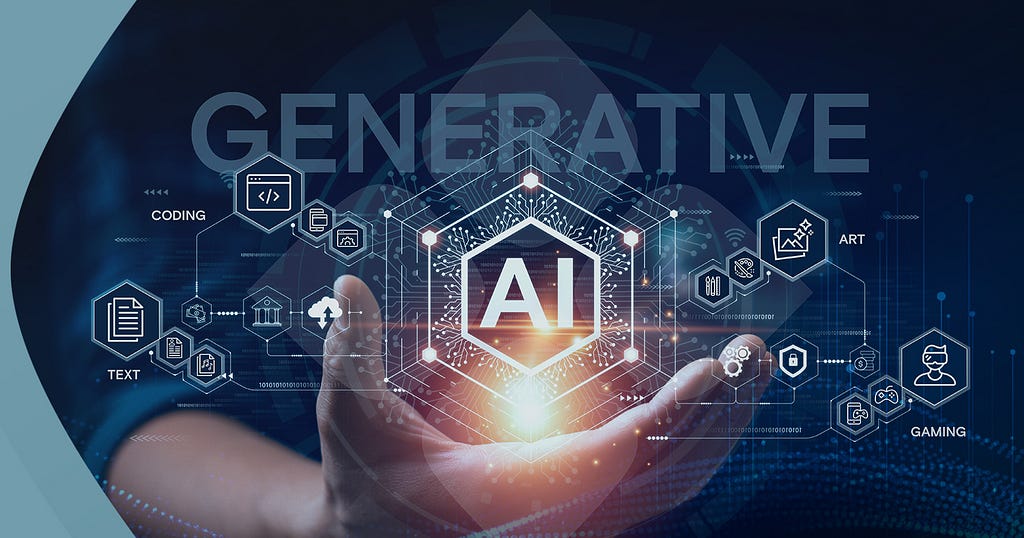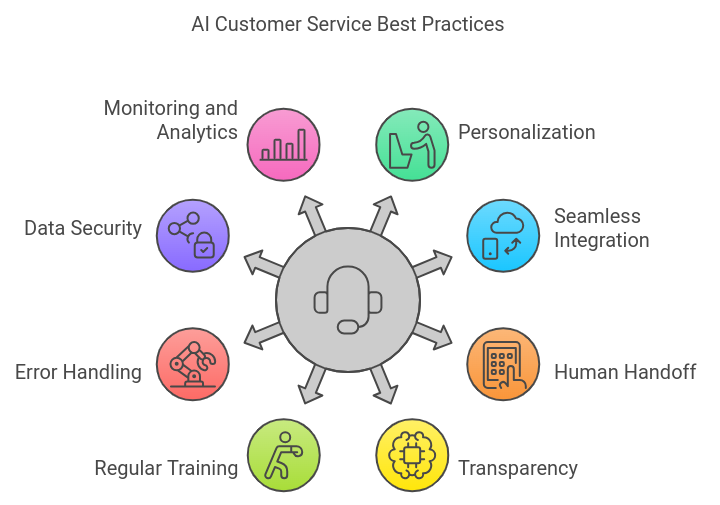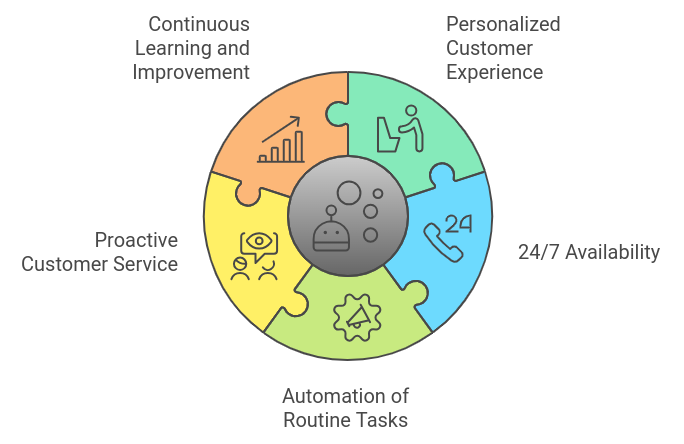Top Strategies for Building Robust AI Code Generation Software
In the age of digital transformation, generative AI has emerged as a powerful tool for enhancing customer service. By leveraging advanced machine learning algorithms, businesses can create more efficient, personalized, and scalable customer support systems. Generative AI helps businesses interact with customers seamlessly, addressing inquiries, resolving issues, and providing tailored recommendations in real-time. Companies across industries are rapidly adopting these AI-driven solutions to enhance their customer support, reduce operational costs, and improve overall user experience.

One of the key advantages of generative AI in customer service is its ability to offer 24/7 support, handling a wide range of queries without human intervention. This provides customers with instant responses, reducing wait times and increasing satisfaction. In this blog, we will explore the top strategies for implementing generative AI in customer service, covering how businesses can integrate AI tools, best practices for training models, and how to strike the right balance between automation and human interaction to deliver the perfect customer service experience.
Table of Content· Table of Content· What is Generative AI in Customer Service?
· Top Strategies for Implementing Generative AI
· Best Practices for AI Customer Service Solutions
· Challenges in Building Generative AI for Customer Service
· Future of Generative AI in Customer Service
· ConclusionWhat is Generative AI in Customer Service?
Generative AI in customer service refers to the use of artificial intelligence technologies, specifically generative models, to enhance and automate customer interactions. It involves using AI systems to understand customer queries, generate relevant responses, and assist in problem-solving, often mimicking human-like conversations. The goal is to improve the customer experience, increase efficiency, and reduce costs.
Here are some key aspects of generative AI in customer service:
Chatbots and Virtual AssistantsGenerative AI powers advanced chatbots and virtual assistants that can handle complex customer queries. Unlike rule-based bots, which follow pre-defined scripts, generative models (like GPT) can create dynamic and personalized responses, improving the quality of interactions.
Automated Ticket ResolutionAI can generate solutions for common customer issues by analyzing past data and providing automated responses. This helps resolve simple queries quickly, allowing human agents to focus on more complex problems.
PersonalizationBy analyzing customer data, generative AI can tailor responses based on the specific needs, preferences, and previous interactions of customers, enhancing the overall service experience.
24/7 AvailabilityAI-powered systems can provide continuous support, answering customer inquiries and resolving issues around the clock, even outside business hours.
Multilingual SupportGenerative AI can handle multiple languages, enabling businesses to serve a global customer base and offer support in various languages without the need for human translators.
Sentiment AnalysisAI can assess the emotional tone of customer messages and adjust responses accordingly, helping businesses manage sensitive situations and provide more empathetic customer service.
Top Strategies for Implementing Generative AIImplementing generative AI successfully requires a strategic approach to ensure it aligns with organizational goals and delivers value. Here are the top strategies for its effective implementation:
Identify Use CasesBegin by identifying specific problems or opportunities where generative AI can add value. This could include content generation, design optimization, or personalized recommendations. Defining clear objectives helps target the AI’s application and measure success.
Start Small with Pilot ProjectsImplement generative AI through pilot projects. By starting with a limited scope, organizations can experiment, refine models, and gauge effectiveness before scaling. Pilot projects provide insights into what works and what needs improvement.
Data Quality and PreparationGenerative AI models need high-quality, clean data for training. It’s essential that the data is accurate, diverse, and reflective of real-world situations to ensure the model’s success. Invest in data collection, cleaning, and pre-processing to enhance model performance.
Leverage Pretrained ModelsUsing pretrained models can accelerate implementation. Many generative AI tools, such as GPT or DALL·E, offer pretrained models that can be fine-tuned for specific tasks, saving time and resources while improving performance.
Integration with Existing SystemsEnsure that generative AI tools integrate seamlessly with existing workflows, tools, and systems. This minimizes disruptions and maximizes productivity, allowing teams to continue leveraging AI outputs effectively within their established processes.
Continuous Monitoring and ImprovementAI models require constant tuning and monitoring. Set up processes to track performance and gather feedback, allowing for ongoing adjustments and refinements. Regular updates ensure that the AI system stays relevant and effective.
Ethics and GovernanceImplement robust ethical guidelines to manage AI usage. This includes fairness, transparency, and accountability in the AI’s decision-making. Ensuring that generative AI adheres to legal and ethical standards builds trust and mitigates risks.
Best Practices for AI Customer Service SolutionsAI-driven customer service solutions can greatly enhance the efficiency and effectiveness of customer interactions. However, to achieve optimal results, it’s crucial to follow best practices:
 Personalization
PersonalizationEnsure AI systems can gather and utilize customer data to personalize interactions. AI should remember previous conversations and preferences to provide tailored responses. Personalization fosters customer loyalty and satisfaction.
Seamless IntegrationAI tools should be integrated smoothly with existing customer service channels, such as chatbots, email, and voice assistants. A unified experience across platforms ensures consistency in communication.
Human Handoff CapabilityWhile AI can resolve many queries, there should be an easy transition to human agents when necessary. Clearly define triggers for handing over a case to a live representative to maintain customer satisfaction in complex situations.
TransparencyCustomers should be aware when they’re interacting with AI. Clear communication helps set expectations, ensuring customers don’t feel deceived by automation. It also builds trust in the technology.
Regular Training and UpdatesAI systems must be trained regularly to handle new queries and adapt to evolving customer needs. Continuous updates to AI models ensure that they stay relevant and improve over time.
Error Handling and LearningWhen AI makes errors, it should be capable of learning from these mistakes. Effective feedback loops and the ability to fine-tune AI algorithms help improve accuracy and avoid recurring issues.
Data SecuritySince AI systems deal with personal customer data, ensuring robust security measures is essential. AI solutions should comply with privacy regulations like GDPR to protect sensitive information.
Monitoring and AnalyticsRegularly monitor AI performance through analytics to measure customer satisfaction, response times, and issue resolution effectiveness. This data can guide further improvements to the system.
Challenges in Building Generative AI for Customer ServiceBuilding generative AI for customer service presents several challenges, despite its potential to enhance automation, efficiency, and customer satisfaction. Here are key hurdles:
Understanding Complex Customer QueriesCustomers may ask questions in various ways, using slang, humor, or even making spelling mistakes. A generative AI must not only comprehend different forms of communication but also understand the context and intent behind a query, which can be difficult, especially when it’s ambiguous or vague.
Ensuring Accurate ResponsesAI models depend on large datasets to produce responses. If the data used for training is incomplete, biased, or outdated, the model could provide incorrect or irrelevant answers. This can be especially damaging in customer service, where accuracy is paramount to maintaining trust and customer loyalty.
PersonalizationEffective customer service requires understanding individual needs. While generative AI can personalize responses based on available data, it can struggle with building a deep understanding of a customer’s history, preferences, and emotional state. Balancing automation with a personalized, human-like touch remains a challenge.
Handling Sensitive DataCustomer interactions often involve personal or sensitive information. Ensuring that generative AI models adhere to privacy laws and security protocols, while also safeguarding data, is a significant challenge, especially when using third-party AI platforms.
Maintaining Natural ConversationsCustomers expect human-like interactions. AI-generated responses may sound robotic or unnatural, particularly when the conversation becomes complex or deviates from standard patterns. Ensuring a fluid, empathetic, and relatable conversation flow is a critical challenge in generative AI for customer service.
Training Costs and TimeBuilding an effective generative AI system requires significant time, effort, and resources to gather relevant datasets, train the model, and continuously fine-tune it. This can be resource-intensive, especially for small to medium-sized businesses.
Future of Generative AI in Customer ServiceThe future of generative AI in customer service holds transformative potential, enabling businesses to offer highly personalized, efficient, and scalable support. As AI technology continues to evolve, customer service will become more seamless and proactive.
 Personalized Customer Experience
Personalized Customer ExperienceGenerative AI will enable businesses to deliver tailored responses by learning from customer data, preferences, and past interactions. Chatbots powered by AI will move beyond scripted responses and engage customers in more human-like conversations, addressing their needs with empathy and context. This personalization will create stronger customer relationships and boost satisfaction.
24/7 AvailabilityAI-driven systems can provide round-the-clock support, eliminating the limitations of human agents’ working hours. This will ensure customers can reach out anytime, with responses being both prompt and accurate. As AI improves, these systems will handle increasingly complex queries, reducing wait times and enhancing overall customer experience.
Automation of Routine TasksGenerative AI will automate repetitive tasks, such as answering frequently asked questions or processing simple requests (e.g., order tracking or billing inquiries). This frees up human agents to focus on more complex issues, ensuring a higher-quality service for customers with unique needs.
Proactive Customer ServiceRather than waiting for customers to initiate contact, generative AI can anticipate problems and reach out proactively. For instance, it could notify customers about issues with their orders, delays, or new product updates, or offer personalized recommendations based on browsing history.
Continuous Learning and ImprovementGenerative AI systems are designed to learn from every interaction, continuously improving their responses and problem-solving abilities. Over time, this leads to more accurate, effective support that adapts to the evolving needs of customers.
ConclusionThe implementation of generative AI in customer service has the potential to revolutionize the way businesses engage with their customers. However, while AI can handle repetitive tasks and queries, human interaction remains essential for more complex situations. A successful strategy involves finding the right balance between automation and human support, ensuring that customers feel valued and heard.
By adopting the right generative AI tools, companies can not only improve efficiency but also provide more personalized experiences, building long-term customer loyalty. As AI technology continues to evolve, staying ahead of the curve and integrating the latest advancements will be crucial for businesses aiming to provide exceptional customer service.
FAQs- What is generative AI in customer service? Generative AI refers to AI models that create human-like responses, allowing businesses to automate customer interactions, answer queries, and resolve issues.
- How can generative AI improve customer service? It can enhance efficiency, reduce response time, offer personalized experiences, and provide consistent support around the clock.
- Can AI fully replace human customer service agents? While AI can handle repetitive tasks, human agents are essential for complex issues requiring empathy and advanced problem-solving.
- What are the best strategies for implementing generative AI in customer service? Strategies include integrating AI-powered chatbots, training models with customer data, and ensuring seamless escalation to human agents when needed.
- Is generative AI cost-effective for customer service? Yes, AI can reduce operational costs by handling high volumes of queries efficiently, minimizing the need for large customer service teams.
Top Strategies for Building Generative AI in Customer Service was originally published in Coinmonks on Medium, where people are continuing the conversation by highlighting and responding to this story.
